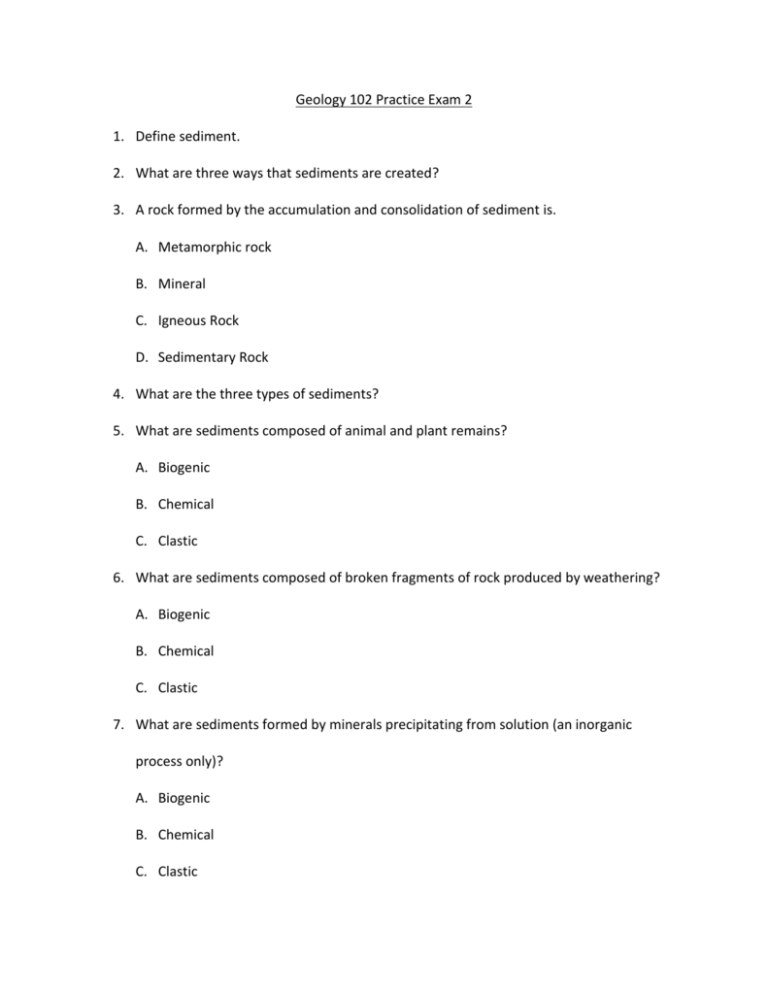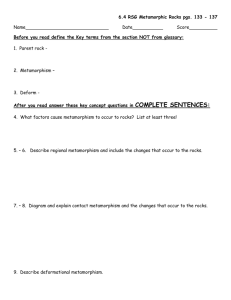Geology 102 Practice Exam 2
advertisement

Geology 102 Practice Exam 2 1. Define sediment. 2. What are three ways that sediments are created? 3. A rock formed by the accumulation and consolidation of sediment is. A. Metamorphic rock B. Mineral C. Igneous Rock D. Sedimentary Rock 4. What are the three types of sediments? 5. What are sediments composed of animal and plant remains? A. Biogenic B. Chemical C. Clastic 6. What are sediments composed of broken fragments of rock produced by weathering? A. Biogenic B. Chemical C. Clastic 7. What are sediments formed by minerals precipitating from solution (an inorganic process only)? A. Biogenic B. Chemical C. Clastic 8. All of the following are examples of sedimentary rocks formed chemically in terrestrial environments, except for? A. Gypsum B. Anhydrite C. Carbonates D. Halite 9. Which of the following is a sedimentary rock that forms chemically in a marine environment? A. Anhydrite B. Coal C. Halite D. Carbonates 10. What is the difference between poorly and well sorted sediments? 11. Define metamorphism. 12. All of the following are factors that influence metamorphism, except for? A. Pressure B. Time C. Pore fluid D. Mineral Composition E. Temperature 13. Below what temperature are most minerals stable with little to no metamorphism (Temperatures are in Celsius)? A. 300 B. 200 C. 250 D. 150 14. Above what temperature will the reaction rate increase as temperature increases and minerals begin to form (Temperatures are in Celsius)? A. 150 B. 200 C. 500 D. 300 15. Above what temperature will some minerals begin to melt and transition into igneous rocks? A. 150 B. 200 C. 450 D. 600 16. What are the three types of metamorphism and their differences? 17. How do you name a clastic sedimentary rock? 18. Which depositional environment would you find coal? A. Source B. Swamp C. Downstream D. Offshore 19. What are the different ways to sort sediments? 20. Changes that occur to a rock while it is solid and does now melt, is known as. A. Lithification B. Foliation C. Crystallization D. Recrystallization 21. What is the parent rock of marble? A. Shale B. Gneiss C. Limestone D. Slate 22. What is the difference between a transgression and a regression? 23. What is the difference between a foliated and nonfoliated metamorphic rock? 24. True or false, the farther a rock clast travels the better rounded and sorted it is. 25. How is coal made? 26. True or false, limestone and coquina are not made from the remains of marine organisms. 27. Which depositional environment are breccia and conglomerate rocks found? A. Beach B. Playa C. Downstream D. Near the source 28. Which depositional environment would you find Quartz sandstone and coquina? A. Beach B. Playa lakes C. Offshore D. Near Source 29. Which depositional environment would you find arkose and lithic sandstone? A. Beach B. Near Source C. Downstream D. Swamp 30. Which depositional environment would you find evaporates? A. Beach B. Playa lakes/basin C. Offshore D. Downstream 31. Which depositional environment would you find siltstone, shale, and limestone? A. Beach B. Downstream C. Swamp D. Offshore 32. What type of metamorphism occurs in areas of mountain building along convergent plate boundaries and the rocks become foliated by differential pressure? A. Contact B. Burial C. Regional D. Low grade 33. Which type of metamorphism occurs where there is high heat, low pressure, and the rocks are in contact with magma? Nonfoliated rocks are found here. A. Contact B. Burial C. Regional 34. What are the heat and pressure conditions for burial metamorphism? 35. What are the heat and pressure conditions for regional metamorphism? 36. Why are contact metamorphic rocks nonfoliated? 37. What is the main difference between a breccia and a conglomerate? A. They are the same B. Breccia have angular grains, while conglomerates have rounded grains C. Conglomerate have angular grains, while breccia have rounded grains D. They both form in different depositional environments 38. Clastic sediment sizes are. A. Gravel, sand, and silt B. Gravel, sand, and mud C. Gravel, mud, and silt 39. What is the parent rock of quartzite? A. Limestone B. Sand C. Slate D. Quartz sandstone 40. What is the parent rock of slate? A. Shale B. Siltstone C. Clay D. Limestone 41. What type of metamorphism forms rocks at low temperatures and pressure, with microscopic crystals, have a dull luster, are composed of clay and mica minerals, and are foliated? A. High grade B. Intermediate grade C. Low grade 42. What type of metamorphism forms rocks at intermediate temperatures and pressure, with small crystals, has a shiny luster, composed of mostly mica minerals, and is foliated? A. High grade B. Intermediate grade C. Low grade 43. What type of metamorphism forms rocks at high temperatures and pressure, with large crystals, is composed of mica minerals, and is foliated? A. High grade B. Intermediate grade C. Low grade 44. What theory describes the formation of the universe? 45. How old is the universe? A. 4.6 billion years old B. 4.6 million years old C. 13.7 million years old D. 13.7 billion years old 46. What theory describes the formation of the solar system? 47. Define planetary differentiation. 48. True or false, schist is the parent rock of gneiss. 49. All of the following are reasons why Earth is unique from other planets, except for? A. Only planet with three states of water B. Life C. Only planet that is differentiated D. Tectonic processes 50. What is the difference between a terrestrial and Jovian planet? 51. The present is the key to the past best describes which principle? A. Principle of catastrophism B. Principle of Unconformities C. The Big Bang Theory D. Principle of Uniformitarianism 52. What are the three types of systems and what are their differences? 53. What is the difference between relative and absolute dating? 54. Layering of sedimentary rocks is known as. A. Columns B. Rows C. Stratum D. Temples 55. A surface between rock layers that represents missing time and occurs due to erosion or non-deposition is known as. A. Disconformity B. Nonconformity C. Unconformity D. Inclusions 56. An unconformity that occurs between parallel layers of sedimentary rocks is known as. A. Nonconformity B. Disconformity C. Angular unconformity 57. An unconformity that occurs between eroded igneous or metamorphic rocks and overlaying sedimentary rock layers is. A. Nonconformity B. Disconformity C. Angular unconformity 58. An unconformity that occurs between lower rocks which have been tilted and then eroded with overlying sedimentary rock layers is. A. Nonconformity B. Disconformity C. Angular unconformity 59. How old is the Earth? A. 4.6 billion years old B. 4.6 million years old C. 13.7 billion years old D. 13.7 million years old 60. Define radioactive decay. 61. What is the difference between alpha and beta radioactive decay. 62. Define an isotope. 63. Be able to calculate the half-life of an isotope.








